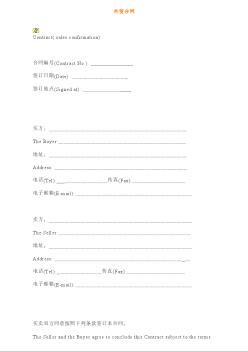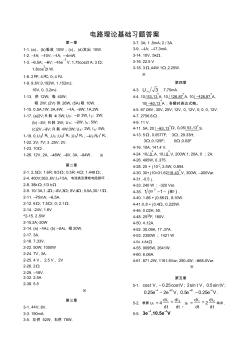Contents
目 录
Chapter 1 Device Physics 器件物理 1
1.1 Semiconductors 半导体 1
1.1.1 Generation and Recombination 产生与复合 4
1.1.2 Extrinsic Semiconductors 非本征(杂质)半导体 6
1.1.3 Diffusion and Drift 扩散和漂移 9
1.2 PN Junctions PN结 11
1.2.1 Depletion Regions 耗尽区 11
1.2.2 PN Diodes PN结二极管 13
1.2.3 Schottky Diodes 肖特基二极管 16
1.2.4 Zener Diodes 齐纳二极管 18
1.2.5 Ohmic Contacts 欧姆接触 19
1.3 Bipolar Junction Transistors 双极型晶体管 21
1.3.1 Beta β值 23
1.3.2 I-V Characteristics I-V特性 24
1.4 MOS Transistors MOS晶体管 25
1.4.1 Threshold Voltage 阈值电压 27
1.4.2 I-V Characteristics I-V特性 29
1.5 JFET Transistors JFET晶体管 32
1.6 Summary 小结 34
1.7 Exercises 习题 35
Chapter 2 Semiconductor Fabrication 半导体制造 37
2.1 Silicon Manufacture 硅制造 37
2.1.1 Crystal Growth 晶体生长 38
2.1.2 Wafer Manufacturing 晶圆制造 39
2.1.3 The Crystal Structure of Silicon 硅的晶体结构 39
2.2 Photolithography 光刻技术 41
2.2.1 Photoresists 光刻胶 41
2.2.2 Photomasks and Reticles 光掩模和掩模版 42
2.2.3 Patterning 光刻 43
2.3 Oxide Growth and Removal 氧化物生长和去除 43
2.3.1 Oxide Growth and Deposition 氧化物生长和淀积 44
2.3.2 Oxide Removal 氧化物去除 45
2.3.3 Other Effects of Oxide Growth and Removal 氧化物生长和去除的其他效应 47
2.3.4 Local Oxidation of Silicon (LOCOS) 硅的局部氧化 49
2.4 Diffusion and Ion Implantation 扩散和离子注入 50
2.4.1 Diffusion 扩散 51
2.4.2 Other Effects of Diffusion 扩散的其他效应53
2.4.3 Ion Implantation 离子注入 55
2.5 Silicon Deposition and Etching 硅淀积和刻蚀 57
2.5.1 Epitaxy 外延 57
2.5.2 Polysilicon Deposition 多晶硅淀积 59
2.5.3 Dielectric Isolation 介质隔离 60
2.6 Metallization 金属化 62
2.6.1 Deposition and Removal of Aluminum 铝淀积及去除 63
2.6.2 Refractory Barrier Metal 难熔阻挡金属 65
2.6.3 Silicidation 硅化 67
2.6.4 Interlevel Oxide, Interlevel Nitride, and Protective Overcoat
夹层氧化物,夹层氮化物和保护层 69
2.6.5 Copper Metallization 铜金属化 71
2.7 Assembly 组装 73
2.7.1 Mount and Bond 安装与键合 74
2.7.2 Packaging 封装 77
2.8 Summary 小结 78
2.9 Exercises 习题 78
Chapter 3 Representative Processes 典型工艺 80
3.1 Standard Bipolar 标准双极工艺 81
3.1.1 Essential Features 本征特性 81
3.1.2 Fabrication Sequence 制造顺序 82
3.1.3 Available Devices 可用器件 86
3.1.4 Process Extensions 工艺扩展 93
3.2 Polysilicon-Gate CMOS 多晶硅栅CMOS工艺 96
3.2.1 Essential Features 本质特征 97
3.2.2 Fabrication Sequence 制造顺序 98
3.2.3 Available Devices 可用器件 104
3.2.4 Process Extensions 工艺扩展 109
3.3 Analog BiCMOS 模拟BiCMOS 114
3.3.1 Essential Features 本质特征 115
3.3.2 Fabrication Sequence 制造顺序 116
3.3.3 Available Devices 可用器件 121
3.3.4 Process Extensions 工艺扩展 125
3.4 Summary 小结 130
3.5 Exercises 习题 131
Chapter 4 Failure Mechanisms 失效机制 133
4.1 Electrical Overstress 电过应力 133
4.1.1 Electrostatic Discharge (ESD) 静电漏放 134
4.1.2 Electromigration 电迁徙 136
4.1.3 Dielectric Breakdown 介质击穿 138
4.1.4 The Antenna Effect 天线效应 141
4.2 Contamination 玷污 143
4.2.1 Dry Corrosion 干法腐蚀 144
4.2.2 Mobile Ion Contamination 可动离子玷污 145
4.3 Surface Effects 表面效应 148
4.3.1 Hot Carrier Injection 热载流子注入 148
4.3.2 Zener Walkout 齐纳蠕变 151
4.3.3 Avalanche-Induced Beta Degradation 雪崩诱发β衰减 153
4.3.4 Negative Bias Temperature Instability 负偏置温度不稳定性 154
4.3.5 Parasitic Channels and Charge Spreading 寄生沟道和电荷分散 156
4.4 Parasitics 寄生效应 164
4.4.1 Substrate Debiasing 衬底去偏置 165
4.4.2 Minority-Carrier Injection 少子注入 169
4.4.3 Substrate Influence 衬底效应 180
4.5 Summary 小结 183
4.6 Exercises 习题 183
Chapter 5 Resistors 电阻 185
5.1 Resistivity and Sheet Resistance 电阻率和方块电阻(薄层电阻) 185
5.2 Resistor Layout 电阻版图 187
5.3 Resistor Variability 电阻变化 191
5.3.1 Process Variation 工艺变化 191
5.3.2 Temperature Variation 温度变化 192
5.3.3 Nonlinearity 非线性 193
5.3.4 Contact Resistance 接触电阻 196
5.4 Resistor Parasitics 电阻的寄生效应 197
5.5 Comparison of Available Resistors 不同电阻类型的比较 200
5.5.1 Base Resistors 基区电阻 200
5.5.2 Emitter Resistors 发射区电阻 201
5.5.3 Base Pinch Resistors 基区埋层电阻 202
5.5.4 High-Sheet Resistors 高值薄层电阻 202
5.5.5 Epi Pinch Resistors 外延埋层电阻 205
5.5.6 Metal Resistors 金属电阻 206
5.5.7 Poly Resistors 多晶硅电阻 208
5.5.8 NSD and PSD Resistors NSD和PSD电阻 211
5.5.9 N-Well Resistors N阱电阻 211
5.5.10 Thin-Film Resistors 薄膜电阻 212
5.6 Adjusting Resistor Values 调整电阻阻值 213
5.6.1 Tweaking Resistors 调节电阻 213
5.6.2 Trimming Resistors 微调电阻 216
5.7 Summary 小结 223
5.8 Exercises 习题 224
Chapter 6 Capacitors and Inductors 电容和电感 226
6.1 Capacitance 电容 226
6.1.1 Capacitor Variability 电容的变化 232
6.1.2 Capacitor Parasitics 电容的寄生效应 235
6.1.3 Comparison of Available Capacitors 电容比较 237
6.2 Inductance 电感 246
6.2.1 Inductor Parasitics 电感寄生效应 248
6.2.2 Inductor Construction 电感的制作 250
6.3 Summary 小结 252
6.4 Exercises 习题 253
Chapter 7 Matching of Resistors and Capacitors 电阻和电容的匹配254
7.1 Measuring Mismatch 失配的测量 254
7.2 Causes of Mismatch 失配的原因 257
7.2.1 Random Variation 随机变化 257
7.2.2 Process Biases 工艺偏差 260
7.2.3 Interconnection Parasitics 互连寄生 261
7.2.4 Pattern Shift 版图移位 263
7.2.5 Etch Rate Variations 刻蚀速率的变化 265
7.2.6 Photolithographic Effects 光刻效应 267
7.2.7 Diffusion Interactions 扩散相互作用 268
7.2.8 Hydrogenation 氢化 270
7.2.9 Mechanical Stress and Package Shift 机械应力和封装漂移 271
7.2.10 Stress Gradients 应力梯度 274
7.2.11 Temperature Gradients and Thermoelectrics 温度梯度和热电效应 283
7.2.12 Electrostatic Interactions 静电影响 288
7.3 Rules for Device Matching 器件匹配规则 295
7.3.1 Rules for Resistor Matching 电阻匹配规则 296
7.3.2 Rules for Capacitor Matching 电容匹配规则 300
7.4 Summary 小结 303
7.5 Exercises 习题 304
Chapter 8 Bipolar Transistors 双极型晶体管306
8.1 Topics in Bipolar Transistor Operation 双极型晶体管的工作原理 306
8.1.1 Beta Rolloff β值下降 308
8.1.2 Avalanche Breakdown 雪崩击穿 308
8.1.3 Thermal Runaway and Secondary Breakdown 热击穿和二次击穿 310
8.1.4 Saturation in NPN Transistors NPN晶体管的饱和状态 312
8.1.5 Saturation in Lateral PNP Transistors 寄生PNP管的饱和状态 315
8.1.6 Parasitics of Bipolar Transistors 双极型晶体管的寄生效应 318
8.2 Standard Bipolar Small-Signal Transistors 标准双极型小信号晶体管 320
8.2.1 The Standard Bipolar NPN Transistor 标准双极型NPN晶体管 320
8.2.2 The Standard Bipolar Substrate PNP Transistor 标准双极工艺衬底PNP晶体管 326
8.2.3 The Standard Bipolar Lateral PNP Transistor 标准双极型横向PNP晶体管 330
8.2.4 High-Voltage Bipolar Transistors 高电压双极型晶体管 337
8.2.5 Super-Beta NPN Transistors 超β NPN晶体管 340
8.3 CMOS and BiCMOS Small-Signal Bipolar Transistors
CMOS和BiCMOS工艺小信号双极型晶体管 341
8.3.1 CMOS PNP Transistors CMOS工艺PNP晶体管 341
8.3.2 Shallow-Well Transistors 浅阱晶体管 345
8.3.3 Analog BiCMOS Bipolar Transistors 模拟BiCMOS双极型晶体管 347
8.3.4 Fast Bipolar Transistors 高速双极型晶体管 349
8.3.5 Polysilicon-Emitter Transistors 多晶硅发射极晶体管 351
8.3.6 Oxide-Isolated Transistors 氧化隔离晶体管 354
8.3.7 Silicon-Germanium Transistors 锗硅晶体管 356
8.4 Summary 小结 358
8.5 Exercises 习题 358
Chapter 9 Applications of Bipolar Transistors 双极型晶体管的应用 360
9.1 Power Bipolar Transistors 功率双极型晶体管 361
9.1.1 Failure Mechanisms of NPN Power Transistors NPN功率晶体管的失效机制 362
9.1.2 Layout of Power NPN Transistors 功率NPN晶体管的版图 368
9.1.3 Power PNP Transistors PNP功率晶体管 376
9.1.4 Saturation Detection and Limiting 饱和检测与限制 378
9.2 Matching Bipolar Transistors 双极型晶体管匹配 381
9.2.1 Random Variations 随机变化 382
9.2.2 Emitter Degeneration 发射区简并 384
9.2.3 NBL Shadow NBL阴影 386
9.2.4 Thermal Gradients 热梯度 387
9.2.5 Stress Gradients 应力梯度 391
9.2.6 Filler-Induced Stress 填充物诱生应力 393
9.2.7 Other Causes of Systematic Mismatch 系统失配的其他因素 395
9.3 Rules for Bipolar Transistor Matching 双极型晶体管匹配设计规则 396
9.3.1 Rules for Matching Vertical Transistors 纵向晶体管匹配规则 397
9.3.2 Rules for Matching Lateral Transistors 横向晶体管匹配规则 400
9.4 Summary 小结 402
9.5 Exercises 习题 403
Chapter 10 Diodes 二极管 406
10.1 Diodes in Standard Bipolar 标准双极工艺二极管 406
10.1.1 Diode-Connected Transistors 二极管连接形式的晶体管 406
10.1.2 Zener Diodes 齐纳二极管 409
10.1.3 Schottky Diodes 肖特基二极管 415
10.1.4 Power Diodes 功率二极管 420
10.2 Diodes in CMOS and BiCMOS Processes CMOS和BiCMOS工艺二极管 422
10.2.1 CMOS Junction Diodes CMOS结型二极管 422
10.2.2 CMOS and BiCMOS Schottky Diodes CMOS和BiCMOS肖特基二极管 423
10.3 Matching Diodes 匹配二极管 425
10.3.1 Matching PN Junction Diodes 匹配PN结二极管 425
10.3.2 Matching Zener Diodes 匹配齐纳二极管 426
10.3.3 Matching Schottky Diodes 匹配肖特基二极管 428
10.4 Summary 小结 428
10.5 Exercises 习题 429
Chapter 11 Field-Effect Transistors 场效应晶体管 430
11.1 Topics in MOS Transistor Operation MOS晶体管的工作原理 431
11.1.1 Modeling the MOS Transistor MOS晶体管建模 431
11.1.2 Parasitics of MOS Transistors 晶体管的寄生参数 438
11.2 Constructing CMOS Transistors 构造CMOS晶体管 446
11.2.1 Coding the MOS Transistor 绘制MOS晶体管版图 447
11.2.2 N-Well and P-Well Processes N阱和P阱工艺 449
11.2.3 Channel Stop Implants 沟道终止注入 452
11.2.4 Threshold Adjust Implants 阈值调整注入 453
11.2.5 Scaling the Transistor 按比例缩小晶体管 456
11.2.6 Variant Structures 不同的结构 459
11.2.7 Backgate Contacts 背栅接触 464
11.3 Floating-Gate Transistors 浮栅晶体管 467
11.3.1 Principles of Floating-Gate Transistor Operation 浮栅晶体管的工作原理 469
11.3.2 Single-Poly EEPROM Memory 单层多晶硅EEPROM存储器 472
11.4 The JFET Transistor JFET晶体管 474
11.4.1 Modeling the JFET JFET建模 474
11.4.2 JFET Layout JFET的版图 476
11.5 Summary 小结 479
11.6 Exercises 习题 479
Chapter 12 Applications of MOS Transistors MOS晶体管的应用482
12.1 Extended-Voltage Transistors 扩展电压晶体管 482
12.1.1 LDD and DDD Transistors LDD和DDD晶体管 483
12.1.2 Extended-Drain Transistors 扩展漏区晶体管 486
12.1.3 Multiple Gate Oxides 多层栅氧化 489
12.2 Power MOS Transistors 功率MOS晶体管 491
12.2.1 MOS Safe Operating Area MOS安全工作区 492
12.2.2 Conventional MOS Power Transistors 常规MOS功率晶体管 498
12.2.3 DMOS Transistors DMOS晶体管 505
12.3 MOS Transistor Matching MOS晶体管的匹配 511
12.3.1 Geometric Effects 几何效应 513
12.3.2 Diffusion and Etch Effects 扩散和刻蚀效应 516
12.3.3 Hydrogenation 氢化作用 520
12.3.4 Thermal and Stress Effects 热效应和应力效应 521
12.3.5 Common-Centroid Layout of MOS Transistors MOS晶体管的共质心布局 523
12.4 Rules for MOS Transistor Matching MOS晶体管的匹配规则 528
12.5 Summary 小结 531
12.6 Exercises 习题 531
Chapter 13 Special Topics 一些专题 534
13.1 Merged Devices 合并器件 534
13.1.1 Flawed Device Mergers 有缺陷的器件合并 535
13.1.2 Successful Device Mergers 成功的器件合并 539
13.1.3 Low-Risk Merged Devices 低风险合并 541
13.1.4 Medium-Risk Merged Devices 中度风险合并器件 542
13.1.5 Devising New Merged Devices 设计新型合并器件 544
13.1.6 The Role of Merged Devices in Analog BiCMOS 模拟BiCMOS中合并器件的作用 544
13.2 Guard Rings 保护环 545
13.2.1 Standard Bipolar Electron Guard Rings 标准双极电子保护环 546
13.2.2 Standard Bipolar Hole Guard Rings 标准双极空穴保护环 547
13.2.3 Guard Rings in CMOS and BiCMOS Designs CMOS和BiCMOS设计中的保护环 548
13.3 Single-level Interconnection 单层互连 551
13.3.1 Mock Layouts and Stick Diagrams 预布版和棒图 551
13.3.2 Techniques for Crossing Leads 交叉布线技术 553
13.3.3 Types of Tunnels 隧道的类型 555
13.4 Constructing the Padring 构建焊盘环 557
13.4.1 Scribe Streets and Alignment Markers 划片线与对准标记 557
13.4.2 Bondpads,Trimpads, and Testpads 焊盘、微调焊盘和测试焊盘 558
13.5 ESD Structures ESD结构 562
13.5.1 Zener Clamp 齐纳钳位 563
13.5.2 Two-Stage Zener Clamps 两级齐纳钳位 565
13.5.3 Buffered Zener Clamp 缓冲齐纳钳位 566
13.5.4 VCES Clamp VCES钳位 568
13.5.5 VECS Clamp VECS钳位 569
13.5.6 Antiparallel Diode Clamps 反向并联二极管钳位 570
13.5.7 Grounded-Gate NMOS Clamps 栅接地NMOS钳位 570
13.5.8 CDM Clamps CDM钳位 572
13.5.9 Lateral SCR Clamps 横向SCR钳位 573
13.5.10 Selecting ESD Structures 选择ESD结构 575
13.6 Exercises 习题 578
Chapter 14 Assembling the Die 组装管芯 581
14.1 Die Planning 规划管芯 581
14.1.1 Cell Area Estimation 单元面积估算 582
14.1.2 Die Area Estimation 管芯面积估算 584
14.1.3 Gross Profit Margin 总利润率 587
14.2 Floorplanning 布局 588
14.3 Top-Level Interconnection 顶层互连 594
14.3.1 Principles of Channel Routing 通道布线原理 594
14.3.2 Special Routing Techniques 特殊布线技术 596
14.3.3 Electromigration 电迁徙 600
14.3.4 Minimizing Stress Effects 减小应力效应 603
14.4 Conclusion 小结 604
14.5 Exercises 习题 605
Appendix A Table of Acronyms Used in the Text 缩写词汇表607
Appendix B The Miller Indices of a Cubic Crystal 立方晶体的米勒指数 611
Appendix C Sample Layout Rules 版图规则实例614
Appendix D Mathematical Derivations 数学公式推导 622
Appendix E Sources for Layout Editor Software 版图编辑软件的出处 627
Index 索引 628

 英文版外贸合同(中英文对照版)
英文版外贸合同(中英文对照版)

 电路理论基础潘双来第二版习题答案
电路理论基础潘双来第二版习题答案